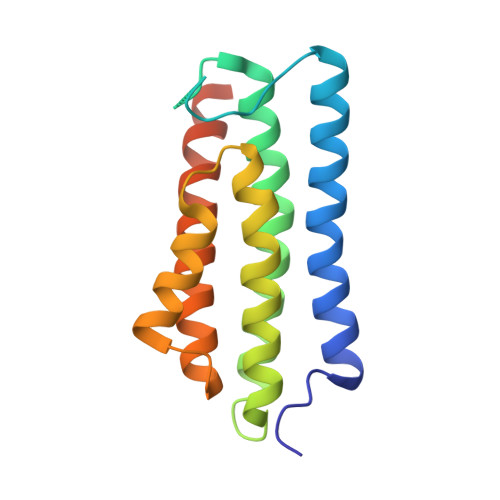Identification of Lysine Residues in the Borrelia burgdorferi DbpA Adhesin Required for Murine Infection.
Fortune, D.E., Lin, Y.P., Deka, R.K., Groshong, A.M., Moore, B.P., Hagman, K.E., Leong, J.M., Tomchick, D.R., Blevins, J.S.(2014) Infect Immun 82: 3186-3198
- PubMed: 24842928
- DOI: https://doi.org/10.1128/IAI.02036-14
- Primary Citation of Related Structures:
4ONR - PubMed Abstract:
Decorin-binding protein A (DbpA) of Borrelia burgdorferi mediates bacterial adhesion to heparin and dermatan sulfate associated with decorin. Lysines K82, K163, and K170 of DbpA are known to be important for in vitro interaction with decorin, and the DbpA structure, initially solved by nuclear magnetic resonance (NMR) spectroscopy, suggests these lysine residues colocalize in a pocket near the C terminus of the protein. In the current study, we solved the structure of DbpA from B. burgdorferi strain 297 using X-ray crystallography and confirmed the existing NMR structural data. In vitro binding experiments confirmed that recombinant DbpA proteins with mutations in K82, K163, or K170 did not bind decorin, which was due to an inability to interact with dermatan sulfate. Most importantly, we determined that the in vitro binding defect observed upon mutation of K82, K163, or K170 in DbpA also led to a defect during infection. The infectivity of B. burgdorferi expressing individual dbpA lysine point mutants was assessed in mice challenged via needle inoculation. Murine infection studies showed that strains expressing dbpA with mutations in K82, K163, and K170 were significantly attenuated and could not be cultured from any tissue. Proper expression and cellular localization of the mutated DbpA proteins were examined, and NMR spectroscopy determined that the mutant DbpA proteins were structurally similar to wild-type DbpA. Taken together, these data showed that lysines K82, K163, and K170 potentiate the binding of DbpA to dermatan sulfate and that an interaction(s) mediated by these lysines is essential for B. burgdorferi murine infection.
Organizational Affiliation:
Department of Microbiology and Immunology, University of Arkansas for Medical Sciences, Little Rock, Arkansas, USA.















